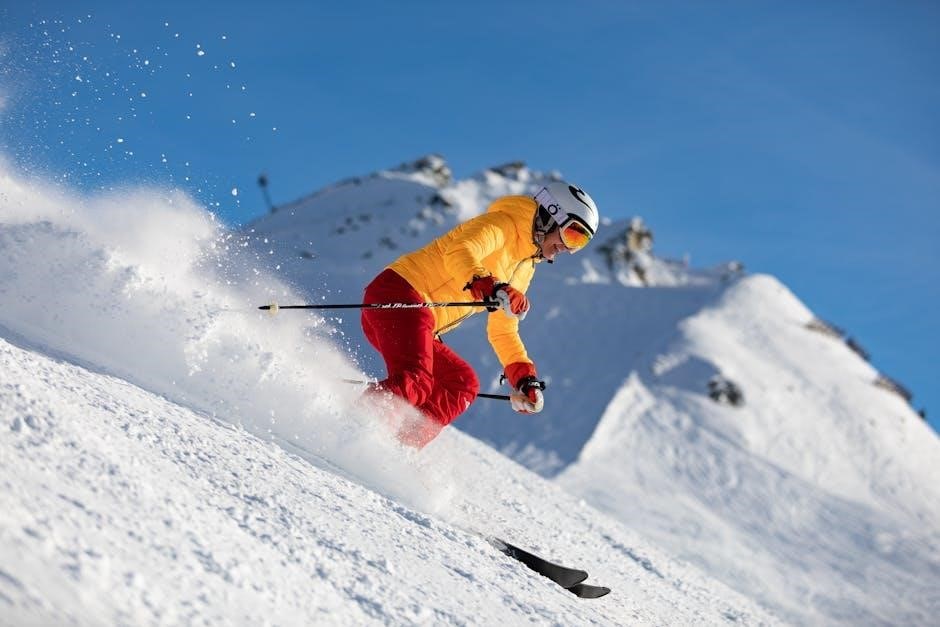
Cross-country skiing, unlike downhill, hinges on weight for proper ski selection. Finding the right size skis is crucial for performance.
This guide demystifies sizing, ensuring comfort and efficiency on the trails. We’ll cover factors, charts, and style-specific advice.
Importance of Proper Ski Sizing
Selecting the correct ski size is paramount for an enjoyable and efficient cross-country skiing experience. Properly sized skis optimize glide, control, and overall performance on the snow. Skis that are too long can be cumbersome, making turning difficult and reducing maneuverability, particularly for beginners. Conversely, skis that are too short may lack the necessary support and stability, leading to inefficient energy transfer and a less responsive feel. Achieving the right balance through proper sizing ensures that skiers can effectively harness their power, maintain balance, and navigate varied terrain with confidence. This enhances not only the physical aspects of the sport but also the overall enjoyment and satisfaction derived from cross-country skiing. Ultimately, investing time in understanding and applying appropriate ski sizing principles translates to a more rewarding and fulfilling experience on the trails.

Factors Influencing Ski Size
Several elements determine the ideal XC ski size. Weight is primary, but skiing style and height also play important roles.
Weight as Primary Determinant
In cross-country skiing, unlike alpine skiing, weight is the most critical factor in determining ski size. Ski manufacturers provide size charts based on skier weight. These charts are essential for selecting the appropriate ski length for optimal performance and control. A ski that is too short for your weight will sink into the snow, making it difficult to glide and maintain speed. Conversely, a ski that is too long will be difficult to control and maneuver, especially on challenging terrain. Proper weight distribution is crucial for efficient skiing, and the right ski size ensures that the ski flexes correctly under your weight, providing the necessary grip and glide. Whether you’re skate skiing, classic cross-country, or Nordic touring, consulting the manufacturer’s weight-based size chart is the first step in selecting the perfect pair of skis for your individual needs and preferences. Ignoring weight guidelines can lead to a less enjoyable and potentially more challenging skiing experience. Always prioritize weight when choosing your cross-country skis to maximize your performance and comfort on the snow.
Skiing Style (Classic, Skate, Backcountry)
The type of cross-country skiing you plan to do significantly impacts the appropriate ski size. Classic skiing involves a striding motion within groomed tracks, requiring longer skis for better glide and tracking. Skate skiing, on the other hand, uses a skating motion on a wider, groomed surface, necessitating shorter, stiffer skis for responsiveness and control. Backcountry skiing, which takes place off-piste in ungroomed terrain, often demands wider and shorter skis for increased flotation and maneuverability in deep snow. Each style places different demands on the skis, influencing their length, width, and stiffness. Classic skis are designed to maximize glide efficiency within tracks, while skate skis prioritize stability and edging power for the skating motion. Backcountry skis are built to handle variable snow conditions and provide the necessary support for off-trail exploration. Selecting the right ski size for your chosen style ensures optimal performance, control, and enjoyment on the snow. Ignoring the style-specific recommendations can lead to inefficient skiing and a less satisfying experience. Therefore, carefully consider your preferred skiing style when determining the appropriate ski size.
XC Ski Size Charts and How to Use Them
Size charts are key to finding the right skis. They use weight primarily, with height as a secondary factor.
Understanding Weight-Based Charts
Weight-based charts are the foundation of cross-country ski sizing. Unlike alpine skiing, where height is a primary factor, cross-country skis rely heavily on your weight to determine the appropriate ski length and stiffness. This is because your weight directly influences how the ski interacts with the snow, particularly the wax pocket in classic skis. These charts provide a range of ski lengths corresponding to different weight ranges. To use them effectively, first, accurately determine your weight, preferably with your typical skiing gear on. Then, locate the weight range on the chart that corresponds to your weight. The chart will then indicate the recommended ski length range. Remember that these charts offer a starting point. Other factors, such as skiing style and skill level, may necessitate adjustments to the recommended ski length. For instance, a beginner might opt for a slightly shorter ski for easier maneuverability, while an experienced skier might prefer a longer ski for increased glide and speed. Always consult the manufacturer’s specific size chart for the ski model you are considering, as these charts can vary slightly between brands.
Height Considerations
While weight is the primary determinant in cross-country ski sizing, height plays a secondary, yet important, role, especially when you fall on the borderline between two weight ranges or when considering different skiing styles. If your weight places you at the upper end of a ski length range on a weight-based chart, and you are also taller than average for your weight, consider opting for the longer ski length within that range. Conversely, if you are at the lower end of the weight range and shorter than average, consider the shorter length. Height becomes particularly relevant when choosing between classic and skate skis. Classic skis typically extend further above your head compared to skate skis. As a general rule, classic skis should be approximately 10-20 cm taller than your height, while skate skis should be around 5-15 cm taller. Furthermore, height can influence pole length selection. Taller skiers will naturally require longer poles to maintain proper technique and efficiency. Therefore, while weight provides the initial guideline for ski length, integrating your height ensures a more personalized and optimal fit for your cross-country skiing experience.
Classic Ski Sizing Guidelines
Classic ski sizing depends on weight and skill. Generally, skis should be longer than your height.
Adjust length based on experience for optimal performance.
Length Recommendations for Classic Skiing
For classic cross-country skiing, the general rule of thumb is to select skis that are approximately 10 to 25 centimeters longer than your height. This additional length provides the necessary surface area for efficient gliding and ensures adequate grip during the kick phase of the classic skiing technique. Beginners might find it easier to start with skis closer to the shorter end of this range, as they offer more maneuverability and control. As your skill level progresses, you can opt for longer skis to enhance glide and speed. Remember to consider your weight as well; if you are lighter for your height, you may want to stay on the shorter side, while heavier skiers might benefit from slightly longer skis to maintain proper ski flex and performance; Consulting a ski sizing chart that takes both height and weight into account is highly recommended for precise fitting.
Skill Level Adjustments
Your skill level plays a significant role in determining the ideal length for your classic cross-country skis. Beginners often benefit from slightly shorter skis within the recommended range. Shorter skis provide enhanced control and maneuverability, making it easier to learn the classic technique and navigate varied terrain; Intermediate skiers can typically opt for skis closer to the middle of the recommended length range, balancing control with increased glide efficiency. Advanced skiers, seeking maximum performance and speed, may choose skis at the longer end of the range. Longer skis offer superior glide and are more efficient for experienced skiers who have mastered the classic technique. However, they require more strength and control to handle effectively. Therefore, it’s crucial to honestly assess your skill level and choose a ski length that complements your abilities and skiing goals. Consulting with experienced skiers or ski shop professionals can also provide valuable guidance in selecting the appropriate ski length based on your individual skill level and preferences.

Skate Ski Sizing Guidelines
Skate ski sizing differs from classic. These skis are stiffer and shorter, optimized for the skating motion and efficient glide.
Length Recommendations for Skate Skiing
When it comes to skate skiing, selecting the appropriate ski length is crucial for maximizing performance and enjoyment on the snow. Unlike classic skis, skate skis are designed to be shorter and stiffer, catering to the dynamic movements and efficient glide required for this style of cross-country skiing. A general rule of thumb for skate ski length is to choose skis that are approximately 5 to 15 centimeters longer than your height. This range allows for optimal control, stability, and speed while skating. However, individual factors such as weight, skill level, and personal preference can also influence the ideal ski length. Lighter skiers may find shorter skis easier to handle, while more experienced skiers might prefer longer skis for increased glide and stability at higher speeds. Consulting a ski size chart that takes into account your weight and height is highly recommended to pinpoint the most suitable skate ski length for your specific needs. Remember, a well-sized skate ski will enhance your skiing experience, allowing you to skate with confidence and efficiency across the trails. Ultimately, the goal is to find a ski length that feels comfortable and responsive, enabling you to fully enjoy the exhilarating sensation of skate skiing. Don’t hesitate to seek advice from experienced skiers or ski shop professionals to further refine your skate ski sizing decision.
XC Ski Boot Sizing
Finding the right boot size ensures comfort and performance. Ill-fitting boots cause blisters and reduce control.
Finding the Right Boot Fit
A proper fit in cross-country ski boots is paramount for comfort, performance, and control. Unlike alpine boots which prioritize downhill performance, XC boots need to allow for a natural stride and efficient energy transfer; When trying on boots, wear the socks you plan to ski in. Your toes should have a little wiggle room, but not so much that your foot slides around. The heel should fit snugly, minimizing lift during push-off. Consider the type of skiing you’ll be doing. Classic boots offer more ankle flex, while skate boots provide stiffer support. Combi boots attempt to bridge the gap. Pay attention to the lacing system. Some boots feature traditional laces, while others use speed lacing or Boa closures. Ensure the lacing system provides even pressure and a secure fit. Walk around in the boots to assess comfort and range of motion. Look for any pressure points or areas of discomfort. If you experience any rubbing or pinching, try a different size or model. Remember that boot fit can also be affected by the type of binding you use. Make sure the boots are compatible with your bindings. Consider the climate you’ll be skiing in. Insulated boots are warmer, but can also be less breathable. Non-insulated boots are lighter and more breathable, but may require warmer socks in cold conditions. Ultimately, the best way to find the right boot fit is to try on a variety of boots and assess their comfort and performance. Don’t hesitate to seek advice from a knowledgeable ski shop employee. They can help you find the perfect boot for your foot shape and skiing style.
Boot Size Charts
Cross-country ski boot sizing can be tricky, as it often differs from standard shoe sizes. Manufacturers typically use Mondopoint sizing, which is based on the length of your foot in millimeters. To find your Mondopoint size, measure your foot from the heel to the tip of your longest toe while wearing ski socks. Most ski boot size charts will then translate this measurement into corresponding US, UK, and European sizes. However, these charts are just a starting point, as sizing can vary between brands and models. It’s always best to try on boots in person to ensure a proper fit. When consulting a size chart, pay attention to whether it’s for men’s or women’s boots, as there can be differences in width and volume. Some charts may also provide additional information, such as the boot’s last width (the width of the boot at its widest point). This can be helpful if you have particularly wide or narrow feet. Keep in mind that ski boot sizes are often listed in half sizes, so you may need to round up or down depending on your foot measurement. If you’re between sizes, it’s generally recommended to go with the larger size, as you can always add thicker socks or an insole to fine-tune the fit. Online retailers often provide size charts for specific brands and models of ski boots. Be sure to consult these charts before making a purchase. Remember that boot fit is crucial for comfort and performance, so take the time to find the right size for your feet. If you’re unsure, consult a professional boot fitter. They can measure your feet, assess your foot shape, and recommend the best boots for your needs.

XC Ski Pole Sizing
Proper pole length is essential for efficient skiing. Skate and classic techniques require different pole lengths. Let’s explore how to measure.
Skate Pole Length Calculation
For skate skiing, pole length is crucial for generating power and maintaining balance. Generally, skate ski poles should reach somewhere between your mouth and nose. A common method for calculating the appropriate length involves multiplying your height in inches by 0.89, or, depending on the chart, adding 10-15 cm to your body size. This will give you a starting point for determining the ideal pole length. It’s important to consider your personal preference and skiing style when making your final decision. Some skiers may prefer slightly longer poles for increased power, while others may opt for shorter poles for better maneuverability. Consider the terrain you will be skiing on. Steeper hills may benefit from slightly shorter poles, while flatter terrain may warrant longer poles. Ultimately, the best way to determine the perfect skate pole length is to experiment and find what feels most comfortable and efficient for you. Remember to maintain a strong core and proper technique to maximize the benefits of correctly sized poles. Don’t hesitate to consult with a ski professional for personalized advice.

Achieving the Perfect Fit
Classic Pole Length Calculation
Classic cross-country skiing relies on proper pole length for efficient striding and balance. Unlike skate skiing, classic poles are shorter, typically reaching from your armpit to the top of your shoulder. A common calculation involves multiplying your height in inches by 0.83, or, depending on the chart, adding 10 cm for beginners, or 10-20 cm for advanced skiers to your body size. This provides a good starting point. However, individual preferences and skiing conditions can influence the ideal length. Consider your skill level; beginners might prefer slightly shorter poles for better control, while experienced skiers may opt for longer poles for increased power in their poling action. The terrain also plays a role; hilly areas might require slightly shorter poles for better uphill climbing. Finding the right classic pole length requires experimentation. Pay attention to how the poles feel as you ski. Are you able to effectively propel yourself forward? Do the poles feel too long or too short? Adjust accordingly until you find a length that allows for a comfortable and efficient stride. Consulting with a ski expert can provide valuable insights.